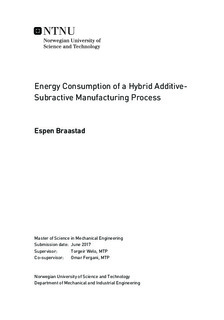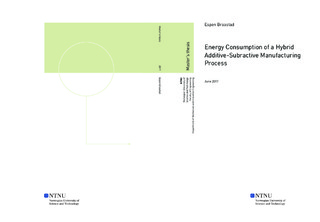| dc.description.abstract | Manufacturing account for a significant portion in the global electricity use and CO2emissions, and it has become essential to mitigate the environmental impact with more efficient manufacturing and resource utilisation (United Nations Environment Program (UNEP), 2011). AdditiveManufacturing (AM) has proven to be a promising manufacturing process regarding environmental and economic aspects, where one of the key environmental benefits of AM has been accounted to material savings. Recently, a new class of manufacturing processes called Hybrid Manufacturing (HM) have emerged, where AM and traditional machining are combined in one machine tool, exploiting the strengths of additive and subtractive manufacturing. As the energy requirements in HM is seldom explored in existing literature, the work of this Master's thesis aims towards developing an energy assessment framework for the HM system. This was achieved by identifying the underlying subsystems as energy consuming units. A system engineering methodology was employed for the design and analysis of the framework. To validate the proposed framework, a case study was designed to investigate the environmental footprint of multiple components made of a Titanium alloy using different processing routes.The outcome of the case study identified the energy consuming units within an HM machine and provided a baseline for a life cycle-based environmental comparison of different manufacturing approaches. The results suggested that the energy consumption in HM is stable, where the auxiliary systems account for the dominant part of the energy consumption and that process parameters not influencing the process time is relatively insignificant. The comparative study showed that AM and HM processes are more environmental friendly for components with small solid-to-cavity ratio. For larger ratios, machining proved to be more efficient. | |

